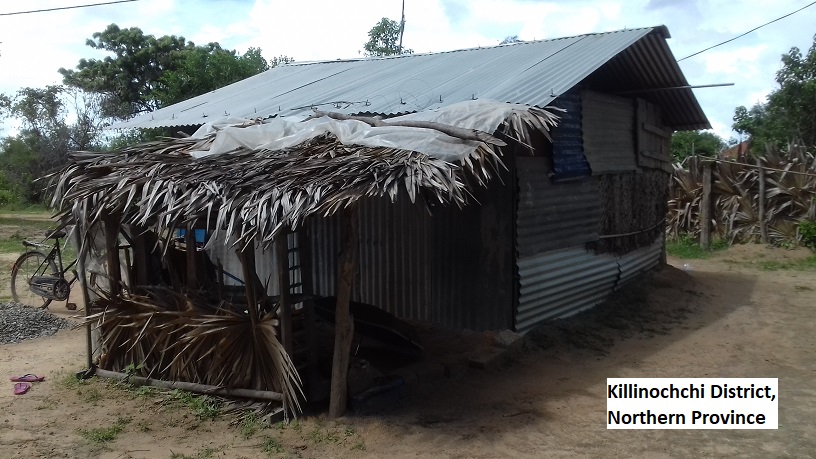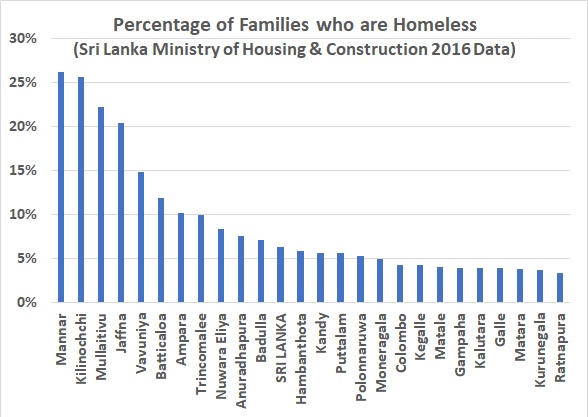By Jekhan Aruliah
In October last year I had the privilege of participating in the blessing of a new water well in the Killinochchi District of the Northern Province. Its construction had been funded by the UK based charity
Child Aid Lanka. The family on whose land the well is built, together with neighbours who also benefit from the new well’s water, had gathered to join in. We were all looking forward to the ceremony and snacks. It was a happy occasion, with the children smartly dressed as if for the well’s birthday party.

As we arrived the father of the family came to greet us, walking easily on his artificial leg. He was very proficient with the prosthetic limb, having had many years of practice on it. It replaced the leg he lost to a mine during the civil war more than nine years ago. He told me he was earning a living as a security guard somewhere in Killinochchi town. With this new well’s water, he would soon be able to spend his time with his family farming their own land. Investing his effort into their own property which each year will become more productive as longer term crops like coconut trees start producing and the land produces vegetation to sustain some chickens, goats and perhaps a cow. Soon he will be earning much more from his land than by squandering his life as a security guard. Not for him a life of keeping an eye on someone else's property in return for a minimal wage. With the new well he would be able to nurture his own land, and after decades of war and poverty at last bring prosperity to his family.
It being late October in the Northern Province, there was a sudden and torrential burst of rain. The family invited us to take shelter inside their home. The house was made from sheets of corrugated metal. Here, with raindrops ringing on the low roof, I saw a single room separated in two by a piece of cloth. It was an old sari dangling from the roof. One side for the parents to sleep, the other side for the children.

This was the first time I had stepped inside such a corrugated metal home. Not because they are rare. In fact, quite the opposite. According to the
Department of Census and Statistics’ most recent
Household Income And Expenditure Survey (HIES) data for 2016 nearly one in ten homes in the Killinochchi district are shanties and slums. Mannar district is not much better off.

[A quick aside to illustrate the old saying “one man’s treasure is another man’s trash”. The Department of Census and Statistics’ figures state that less than 1% of homes in Colombo fall into the slum and shanty category. On the other hand the
Western Megapolis Masterplan states “
Over fifty percent of the Colombo city population lives in shanties, slums or dilapidated old housing schemes”!]
If the above data is depressing, worse is yet to come. The HIES data provides the
percentage of homes that are slums and shanties. What about people
without homes? Who are effectively ignored in the HIES data? For this we need to look at data from the
Ministry of Housing & Construction’s report for 2016 titled “
Housing Need Assessment and Data Survey”.

“Homeless” can mean anything from sleeping rough in the open, to living in cattle sheds, to living with friends or relations until a home can be found. It doesn’t include those living in slums and shanties, nor those with their own rented accommodation.
Bringing together the most recent Department of Census & Statistics and the Ministry of Housing & Construction figures suggest that in 2016 there were about 90,000 families in the Northern Province who were living in shanties, slums, or were homeless.
In 2015 the newly elected government
promised 65,000 new houses for the former conflict areas. Having spent the years since then
squabbling over what the houses should be made of and who should build them, so far in 2018 they still haven’t been delivered.
Why not get on with it? It’s not hard to find those who can do the job of building large numbers of such homes. Since 2010 the
Red Cross and the
Indian Government have built tens of thousands of houses in the former war zones.
More than 9 years after the end of the civil war, these northern districts remain in a far worse economic state than the rest of the country. The government needs to get on with it.
( — The writer Jekhan Aruliah was born in Sri Lanka and moved with his family to the UK when he was two years of age. Brought up in London, he graduated from Cambridge University in 1986 with a degree in Natural Sciences. Jekhan then spent over two decades in the IT industry, for half of which he was managing offshore software development for British companies in Colombo and in Gurgaon (India). In 2015 Jekhan decided to move to Jaffna where he is now involved in social and economic projects. He can be contacted at jekhanaruliah@gmail.com — )
 As we arrived the father of the family came to greet us, walking easily on his artificial leg. He was very proficient with the prosthetic limb, having had many years of practice on it. It replaced the leg he lost to a mine during the civil war more than nine years ago. He told me he was earning a living as a security guard somewhere in Killinochchi town. With this new well’s water, he would soon be able to spend his time with his family farming their own land. Investing his effort into their own property which each year will become more productive as longer term crops like coconut trees start producing and the land produces vegetation to sustain some chickens, goats and perhaps a cow. Soon he will be earning much more from his land than by squandering his life as a security guard. Not for him a life of keeping an eye on someone else's property in return for a minimal wage. With the new well he would be able to nurture his own land, and after decades of war and poverty at last bring prosperity to his family.
It being late October in the Northern Province, there was a sudden and torrential burst of rain. The family invited us to take shelter inside their home. The house was made from sheets of corrugated metal. Here, with raindrops ringing on the low roof, I saw a single room separated in two by a piece of cloth. It was an old sari dangling from the roof. One side for the parents to sleep, the other side for the children.
As we arrived the father of the family came to greet us, walking easily on his artificial leg. He was very proficient with the prosthetic limb, having had many years of practice on it. It replaced the leg he lost to a mine during the civil war more than nine years ago. He told me he was earning a living as a security guard somewhere in Killinochchi town. With this new well’s water, he would soon be able to spend his time with his family farming their own land. Investing his effort into their own property which each year will become more productive as longer term crops like coconut trees start producing and the land produces vegetation to sustain some chickens, goats and perhaps a cow. Soon he will be earning much more from his land than by squandering his life as a security guard. Not for him a life of keeping an eye on someone else's property in return for a minimal wage. With the new well he would be able to nurture his own land, and after decades of war and poverty at last bring prosperity to his family.
It being late October in the Northern Province, there was a sudden and torrential burst of rain. The family invited us to take shelter inside their home. The house was made from sheets of corrugated metal. Here, with raindrops ringing on the low roof, I saw a single room separated in two by a piece of cloth. It was an old sari dangling from the roof. One side for the parents to sleep, the other side for the children.
 This was the first time I had stepped inside such a corrugated metal home. Not because they are rare. In fact, quite the opposite. According to the Department of Census and Statistics’ most recent Household Income And Expenditure Survey (HIES) data for 2016 nearly one in ten homes in the Killinochchi district are shanties and slums. Mannar district is not much better off.
This was the first time I had stepped inside such a corrugated metal home. Not because they are rare. In fact, quite the opposite. According to the Department of Census and Statistics’ most recent Household Income And Expenditure Survey (HIES) data for 2016 nearly one in ten homes in the Killinochchi district are shanties and slums. Mannar district is not much better off.
 [A quick aside to illustrate the old saying “one man’s treasure is another man’s trash”. The Department of Census and Statistics’ figures state that less than 1% of homes in Colombo fall into the slum and shanty category. On the other hand the Western Megapolis Masterplan states “Over fifty percent of the Colombo city population lives in shanties, slums or dilapidated old housing schemes”!]
If the above data is depressing, worse is yet to come. The HIES data provides the percentage of homes that are slums and shanties. What about people without homes? Who are effectively ignored in the HIES data? For this we need to look at data from the Ministry of Housing & Construction’s report for 2016 titled “Housing Need Assessment and Data Survey”.
[A quick aside to illustrate the old saying “one man’s treasure is another man’s trash”. The Department of Census and Statistics’ figures state that less than 1% of homes in Colombo fall into the slum and shanty category. On the other hand the Western Megapolis Masterplan states “Over fifty percent of the Colombo city population lives in shanties, slums or dilapidated old housing schemes”!]
If the above data is depressing, worse is yet to come. The HIES data provides the percentage of homes that are slums and shanties. What about people without homes? Who are effectively ignored in the HIES data? For this we need to look at data from the Ministry of Housing & Construction’s report for 2016 titled “Housing Need Assessment and Data Survey”.
 “Homeless” can mean anything from sleeping rough in the open, to living in cattle sheds, to living with friends or relations until a home can be found. It doesn’t include those living in slums and shanties, nor those with their own rented accommodation.
Bringing together the most recent Department of Census & Statistics and the Ministry of Housing & Construction figures suggest that in 2016 there were about 90,000 families in the Northern Province who were living in shanties, slums, or were homeless.
In 2015 the newly elected government promised 65,000 new houses for the former conflict areas. Having spent the years since then squabbling over what the houses should be made of and who should build them, so far in 2018 they still haven’t been delivered.
Why not get on with it? It’s not hard to find those who can do the job of building large numbers of such homes. Since 2010 the Red Cross and the Indian Government have built tens of thousands of houses in the former war zones.
More than 9 years after the end of the civil war, these northern districts remain in a far worse economic state than the rest of the country. The government needs to get on with it.
( — The writer Jekhan Aruliah was born in Sri Lanka and moved with his family to the UK when he was two years of age. Brought up in London, he graduated from Cambridge University in 1986 with a degree in Natural Sciences. Jekhan then spent over two decades in the IT industry, for half of which he was managing offshore software development for British companies in Colombo and in Gurgaon (India). In 2015 Jekhan decided to move to Jaffna where he is now involved in social and economic projects. He can be contacted at jekhanaruliah@gmail.com — )
“Homeless” can mean anything from sleeping rough in the open, to living in cattle sheds, to living with friends or relations until a home can be found. It doesn’t include those living in slums and shanties, nor those with their own rented accommodation.
Bringing together the most recent Department of Census & Statistics and the Ministry of Housing & Construction figures suggest that in 2016 there were about 90,000 families in the Northern Province who were living in shanties, slums, or were homeless.
In 2015 the newly elected government promised 65,000 new houses for the former conflict areas. Having spent the years since then squabbling over what the houses should be made of and who should build them, so far in 2018 they still haven’t been delivered.
Why not get on with it? It’s not hard to find those who can do the job of building large numbers of such homes. Since 2010 the Red Cross and the Indian Government have built tens of thousands of houses in the former war zones.
More than 9 years after the end of the civil war, these northern districts remain in a far worse economic state than the rest of the country. The government needs to get on with it.
( — The writer Jekhan Aruliah was born in Sri Lanka and moved with his family to the UK when he was two years of age. Brought up in London, he graduated from Cambridge University in 1986 with a degree in Natural Sciences. Jekhan then spent over two decades in the IT industry, for half of which he was managing offshore software development for British companies in Colombo and in Gurgaon (India). In 2015 Jekhan decided to move to Jaffna where he is now involved in social and economic projects. He can be contacted at jekhanaruliah@gmail.com — ) 
